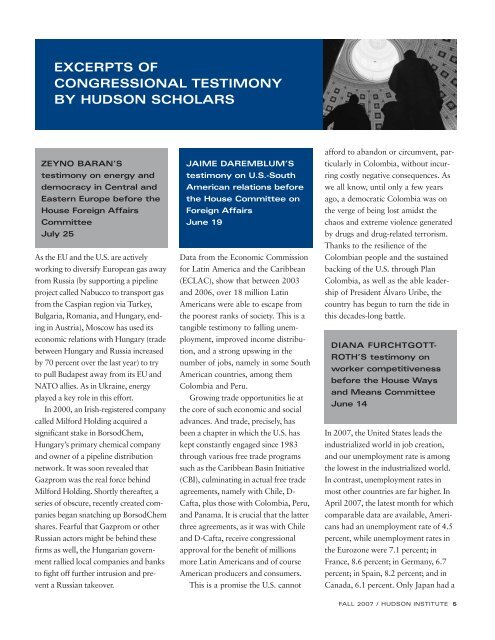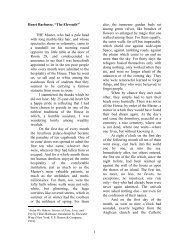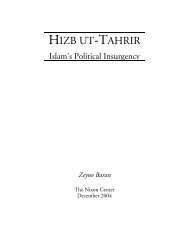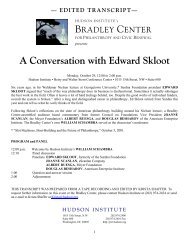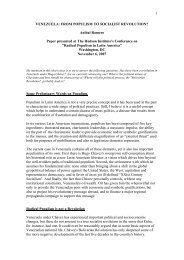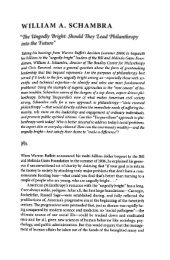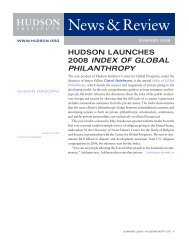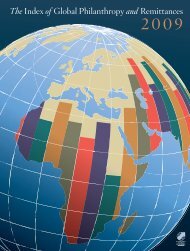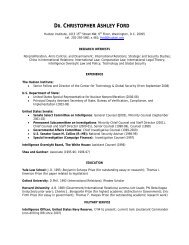Create successful ePaper yourself
Turn your PDF publications into a flip-book with our unique Google optimized e-Paper software.
EXCERPTS OF<br />
CONGRESSIONAL TESTIMONY<br />
BY HUDSON SCHOLARS<br />
ZEYNO BARAN’S<br />
testimony on energy and<br />
democracy in Central and<br />
Eastern Europe before the<br />
House Foreign Affairs<br />
Committee<br />
July 25<br />
As the EU and the U.S. are act ive ly<br />
working to diversify European gas away<br />
from Russia (by supporting a pipe line<br />
project called Nabucco to trans port gas<br />
from the Caspian region via Turkey,<br />
Bulgaria, Romania, and Hun gary, ending<br />
in Austria), Moscow has used its<br />
economic relations with Hungary (trade<br />
between Hungary and Russia increased<br />
by 70 percent over the last year) to try<br />
to pull Budapest away from its EU and<br />
NATO allies. As in Uk raine, energy<br />
played a key role in this effort.<br />
In 2000, an Irish-registered company<br />
called Milford Holding acquired a<br />
significant stake in BorsodChem,<br />
Hun gary’s primary chemical company<br />
and owner of a pipeline distribution<br />
network. It was soon revealed that<br />
Gaz prom was the real force behind<br />
Mil ford Holding. Shortly thereafter, a<br />
series of obscure, recently created com -<br />
panies began snatching up BorsodChem<br />
shares. Fearful that Gazprom or other<br />
Russian actors might be behind these<br />
firms as well, the Hungarian government<br />
rallied local companies and banks<br />
to fight off further intrusion and prevent<br />
a Russian takeover.<br />
JAIME DAREMBLUM’S<br />
testimony on U.S.-South<br />
American relations before<br />
the House Committee on<br />
Foreign Affairs<br />
June 19<br />
Data from the Economic Commission<br />
for Latin America and the Caribbean<br />
(ECLAC), show that between 2003<br />
and 2006, over 18 million Latin<br />
Americans were able to escape from<br />
the poorest ranks of society. This is a<br />
tangible testimony to falling unemployment,<br />
improved income distribution,<br />
and a strong upswing in the<br />
number of jobs, namely in some South<br />
American countries, among them<br />
Colombia and Peru.<br />
Growing trade opportunities lie at<br />
the core of such economic and social<br />
advances. And trade, precisely, has<br />
been a chapter in which the U.S. has<br />
kept constantly engaged since 1983<br />
through various free trade programs<br />
such as the Caribbean Basin Initiative<br />
(CBI), culminating in actual free trade<br />
agreements, namely with Chile, D-<br />
Cafta, plus those with Colombia, Peru,<br />
and Panama. It is crucial that the latter<br />
three agreements, as it was with Chile<br />
and D-Cafta, receive congressional<br />
approval for the benefit of millions<br />
more Latin Americans and of course<br />
American producers and consumers.<br />
This is a promise the U.S. cannot<br />
afford to abandon or circumvent, particularly<br />
in Colombia, without incurring<br />
costly negative consequences. As<br />
we all know, until only a few years<br />
ago, a democratic Colombia was on<br />
the verge of being lost amidst the<br />
chaos and extreme violence generated<br />
by drugs and drug-related terrorism.<br />
Thanks to the resilience of the<br />
Colombian people and the sustained<br />
backing of the U.S. through Plan<br />
Colombia, as well as the able leadership<br />
of President Álvaro Uribe, the<br />
country has begun to turn the tide in<br />
this decades-long battle.<br />
DIANA FURCHTGOTT-<br />
ROTH’S testimony on<br />
worker competitiveness<br />
before the House Ways<br />
and Means Committee<br />
June 14<br />
In 2007, the United States leads the<br />
industrialized world in job creation,<br />
and our unemployment rate is among<br />
the lowest in the industrialized world.<br />
In contrast, unemployment rates in<br />
most other countries are far higher. In<br />
April 2007, the latest month for which<br />
comparable data are available, Ameri -<br />
cans had an unemployment rate of 4.5<br />
percent, while unemployment rates in<br />
the Eurozone were 7.1 per cent; in<br />
France, 8.6 percent; in Germany, 6.7<br />
percent; in Spain, 8.2 percent; and in<br />
Canada, 6.1 percent. Only Japan had a<br />
FALL 2007 / HUDSON INSTITUTE 5


